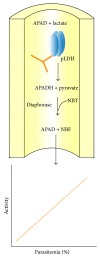Potential biomarkers and their applications for rapid and reliable detection of malaria
- PMID: 24804253
- PMCID: PMC3996934
- DOI: 10.1155/2014/852645
Potential biomarkers and their applications for rapid and reliable detection of malaria
Abstract
Malaria has been responsible for the highest mortality in most malaria endemic countries. Even after decades of malaria control campaigns, it still persists as a disease of high mortality due to improper diagnosis and rapidly evolving drug resistant malarial parasites. For efficient and economical malaria management, WHO recommends that all malaria suspected patients should receive proper diagnosis before administering drugs. It is thus imperative to develop fast, economical, and accurate techniques for diagnosis of malaria. In this regard an in-depth knowledge on malaria biomarkers is important to identify an appropriate biorecognition element and utilize it prudently to develop a reliable detection technique for diagnosis of the disease. Among the various biomarkers, plasmodial lactate dehydrogenase and histidine-rich protein II (HRP II) have received increasing attention for developing rapid and reliable detection techniques for malaria. The widely used rapid detection tests (RDTs) for malaria succumb to many drawbacks which promotes exploration of more efficient economical detection techniques. This paper provides an overview on the current status of malaria biomarkers, along with their potential utilization for developing different malaria diagnostic techniques and advanced biosensors.
Figures







Similar articles
-
Recent Advances in the Development of Biosensors for Malaria Diagnosis.Sensors (Basel). 2020 Feb 1;20(3):799. doi: 10.3390/s20030799. Sensors (Basel). 2020. PMID: 32024098 Free PMC article. Review.
-
Diagnostic accuracy and limit of detection of ten malaria parasite lactate dehydrogenase-based rapid tests for Plasmodium knowlesi and P. falciparum.Front Cell Infect Microbiol. 2022 Oct 17;12:1023219. doi: 10.3389/fcimb.2022.1023219. eCollection 2022. Front Cell Infect Microbiol. 2022. PMID: 36325471 Free PMC article.
-
Ultra-sensitive RDT performance and antigen dynamics in a high-transmission Plasmodium falciparum setting in Mali.Malar J. 2020 Sep 3;19(1):323. doi: 10.1186/s12936-020-03389-0. Malar J. 2020. PMID: 32883286 Free PMC article.
-
Clinical diagnostic evaluation of HRP2 and pLDH-based rapid diagnostic tests for malaria in an area receiving seasonal malaria chemoprevention in Niger.Malar J. 2019 Dec 26;18(1):443. doi: 10.1186/s12936-019-3079-1. Malar J. 2019. PMID: 31878947 Free PMC article.
-
Malaria rapid diagnostic tests: challenges and prospects.J Med Microbiol. 2013 Oct;62(Pt 10):1491-1505. doi: 10.1099/jmm.0.052506-0. J Med Microbiol. 2013. PMID: 24048274 Review.
Cited by
-
Revolution in malaria detection: unveiling current breakthroughs and tomorrow's possibilities in biomarker innovation.Ann Med Surg (Lond). 2024 Jul 17;86(10):5859-5876. doi: 10.1097/MS9.0000000000002383. eCollection 2024 Oct. Ann Med Surg (Lond). 2024. PMID: 39359838 Free PMC article. Review.
-
Liquid Redox Probe-Free Plastic Antibody Development for Malaria Biomarker Recognition.ACS Omega. 2024 Jul 15;9(30):33130-33139. doi: 10.1021/acsomega.4c04543. eCollection 2024 Jul 30. ACS Omega. 2024. PMID: 39100316 Free PMC article.
-
Host metabolomic responses in recurrent P. vivax malaria.Sci Rep. 2024 Mar 27;14(1):7249. doi: 10.1038/s41598-024-54231-5. Sci Rep. 2024. PMID: 38538661 Free PMC article.
-
Paper-Based Microfluidic Chips for Food Hazard Factor Detection: Fabrication, Modification, and Application.Foods. 2023 Nov 13;12(22):4107. doi: 10.3390/foods12224107. Foods. 2023. PMID: 38002165 Free PMC article. Review.
-
Genetic diversity of Plasmodium falciparum among asymptomatic pregnant women on intermittent preventive treatment with sulfadoxine-pyrimethamine in Nigeria.Afr Health Sci. 2023 Mar;23(1):765-773. doi: 10.4314/ahs.v23i1.80. Afr Health Sci. 2023. PMID: 37545953 Free PMC article.
References
-
- WHO world malaria report 2012. http://www.who.int/malaria/publications/world_malaria_report_2012/wmr201....
-
- Centres for Disease Control and Prevention. http://www.cdc.gov/malaria/about/biology/parasites.html.
-
- Choi S-R, Beeler AB, Pradhan A, et al. Generation of oxamic acid libraries: antimalarials and inhibitors of plasmodium falciparum lactate dehydrogenase. Journal of Combinatorial Chemistry. 2007;9(2):292–300. - PubMed
-
- Chanda P, Hamainza B, Mulenga S, Chalwe V, Msiska C, Chizema-Kawesha E. Early results of integrated malaria control and implications for the management of fever in under-five children at a peripheral health facility: a case study of Chongwe rural health centre in Zambia. Malaria Journal. 2009;8(1, article 49) - PMC - PubMed
Publication types
MeSH terms
Substances
LinkOut - more resources
Full Text Sources
Other Literature Sources
Medical

